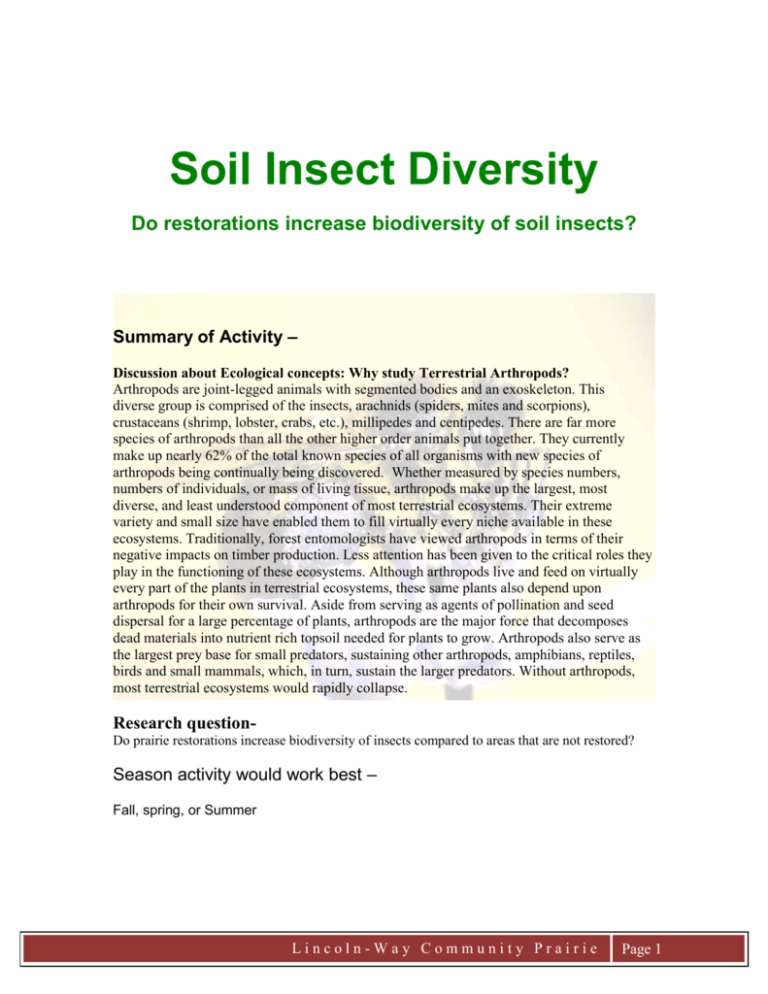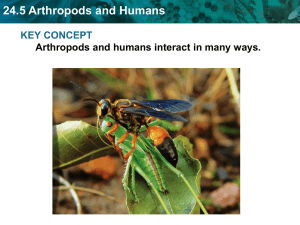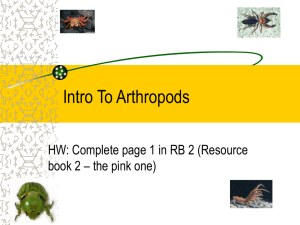Soil Insects - Lincoln-Way Community High School District 210
advertisement

Soil Insect Diversity Do restorations increase biodiversity of soil insects? Summary of Activity – Discussion about Ecological concepts: Why study Terrestrial Arthropods? Arthropods are joint-legged animals with segmented bodies and an exoskeleton. This diverse group is comprised of the insects, arachnids (spiders, mites and scorpions), crustaceans (shrimp, lobster, crabs, etc.), millipedes and centipedes. There are far more species of arthropods than all the other higher order animals put together. They currently make up nearly 62% of the total known species of all organisms with new species of arthropods being continually being discovered. Whether measured by species numbers, numbers of individuals, or mass of living tissue, arthropods make up the largest, most diverse, and least understood component of most terrestrial ecosystems. Their extreme variety and small size have enabled them to fill virtually every niche available in these ecosystems. Traditionally, forest entomologists have viewed arthropods in terms of their negative impacts on timber production. Less attention has been given to the critical roles they play in the functioning of these ecosystems. Although arthropods live and feed on virtually every part of the plants in terrestrial ecosystems, these same plants also depend upon arthropods for their own survival. Aside from serving as agents of pollination and seed dispersal for a large percentage of plants, arthropods are the major force that decomposes dead materials into nutrient rich topsoil needed for plants to grow. Arthropods also serve as the largest prey base for small predators, sustaining other arthropods, amphibians, reptiles, birds and small mammals, which, in turn, sustain the larger predators. Without arthropods, most terrestrial ecosystems would rapidly collapse. Research questionDo prairie restorations increase biodiversity of insects compared to areas that are not restored? Season activity would work best – Fall, spring, or Summer Lincoln-Way Community Prairie Page 1 Equipment neededField Notebook Pencil Hand Lens or Dissecting Scope Liter pop containers, yogurt containers Antifreeze (polypropylene glycol) 80 meters of string Compass Map of study site Trowels (one per group) Id keys Petri Dishes Preserving vials 70 % Ethanol Digital Camera ProcedureStep 1: Setting up Transects and Traps1. You will need to have two study groups (restoration site and non-restoration site) , therefore you will need to have two ground zeros. 2. A transect is a line set up on your study site to help make your experiment random. This line usually is a length of string held up by to stakes. 3. Our lines will be from ground zero ( a place on your site designated by teacher.) 4. Each line will be ten meters long 5. From ground zero, measure out a north transect line, south transect line, east transect line, and west transect line. 6. Randomly select a 2.5 m location on one line, a 5m location on another line, a 7.5 m location on the third transect line, and finally a 10 m location on the last line. Place a piece of tape on each location. 7. This will mark where your pitfall traps will go. You will have a total of four traps for restoration site and four traps for non-restoration site. Step 2: Creating Pitfall traps Lincoln-Way Community Prairie Page 2 Step 3: Digging Pitfall Traps Lincoln-Way Community Prairie Page 3 1. At each piece of tape along transect line, using a trowel, dig a hole slightly wider and deeper than the trap saving the removed soil to the side. Place the trap in the hole with the plastic container in the top (to keep dirt out of the trap). Position the trap in the hole making sure the top of the trap is at ground level. 2. Using your hands, fill the hole around the trap with the saved soil. Firmly compact the soil around the trap and make it flush with the edge of the trap. Remember, you want arthropods to “tumble in”. Save the remaining soil to fill the hole later. 3. Remove the funnel and the plastic container which served as a lid. Pour 5-10mL of antifreeze into the collection dish in the bottom of the trap. The antifreeze acts as a preservative for your specimens. Re-insert the funnel into the trap and check the soil around the edge. 4. To create a “roof” for your trap, find two short sticks and a piece of bark larger than the opening to the trap. Or, in the absence of bark, use an alternative covering. Lay the sticks on two sides of the trap opening and cover with bark. The sticks should hold the bark off the ground and over the trap to protect it from rain but allow for easy access by the arthropods. 5. Mark the location of your trap and collect your unused materials. Leave pitfall traps out for approximately 1 week in the fall or late spring, 3-4 weeks in winter or early spring. Step 4: Removing the Traps in the Field/ Begin Sorting in Lab 1. Traps can be removed from the field by covering each container, and lifting the liter bottle from the hole. Fill up the holes, they can be hazardous. Return to lab. 2. Students should recycle the antifreeze by decanting their samples into a beaker through filter paper. 3. Samples can be sorted using a dissecting scope or the naked eye into like groups on Petri plates, carefully keeping each pitfall sample separate. Discard/Don't use any organisms smaller than 2 mm. They are most likely organisms that fell into the trap by mistake. Step 5: Continue Sorting and Begin Identification 1. Complete sorting and, using an ID key, begin identifying terrestrial invertebrates. If you don’t know what species something is, then assign it a letter or number, such as spider 1, spider 2, etc. 2. Option: Take digital pictures of difficult invertebrates 3. Record data in data sheets with appropriate names and numbers. 4. Option: preserve some specimens with labels for an insect collection. Step 6: Data Analysis 1. Compete a data table for all data 2. Graph your data comparing a restoration site compared to a non-restoration site. Going FurtherLincoln-Way Community Prairie Page 4 1. Using your data, explain utilizing your data the relationship between diversity of plants and diversity of insects. 2. What benefits do insects have a prairie restoration? 3. If you were a restoration ecologist, how would you ensure that insects were included in a restoration? Explain. Additional resources – Lincoln-Way Community Prairie Page 5








